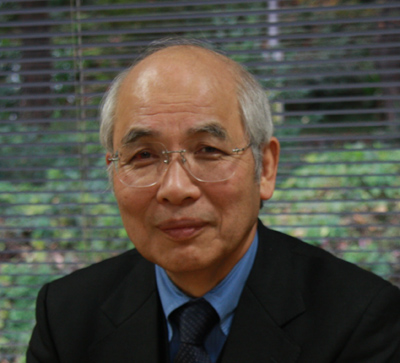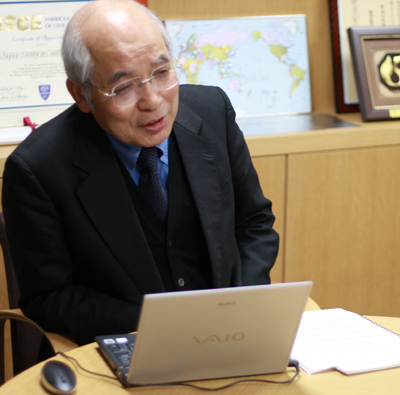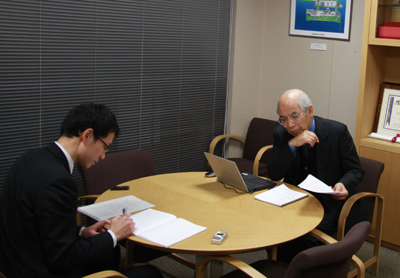| SPECIAL REPORT |
 |
| Interview with
Kenji Sakata, President of JSCE president, about the environmental issues related to
concrete structures |
Dr. K.Sakata is a specialist in concrete structures, especially on creep,
shrinkage, and durability of concrete. He was appointed as Emeritus Professor
by Okayama University in 2009 and also served as the president of Japan
Concrete Institute and Japan Society of Dam Engineers. Detail profile can
be seen in the following website.
(http://www.jsce-int.org/president/president_2010.shtml). |
| PDF version |
|
| Q: |
Please tell us about the environmental themes you are working on at present.
|
| A: |
First, from the point of view of mitigation, there are two aspects to construction
materials including concrete: there is the negative aspect of carbon dioxide
emissions on the one hand, and there is the good aspect of materials for
infrastructure development as adaptation. These two aspects conflict, and
considering the environment, their balance is extremely difficult.
Also, there is an extremely close relationship between global warming and biodiversity.
If global warming is not solved, the balance in the ecosystem will collapse, so the lifestyle of humans
who are also one of the living creatures will also collapse. In other words, it is necessary to consider problems such as warming including biodiversity.
I believe the world is in a crisis situation regarding global warming, and I have my doubts whether the world correctly recognizes this situation.
They say the 21st century is the water century.
This is because various problems related to water will occur, such as the disappearance of glaciers, rising sea levels, great floods, catastrophic droughts, etc.
Japan is a special country; a lot of rain falls, but soon after falling it flows into the sea. Therefore in mountain areas dams are constructed to store the water.
On the other hand, in America dams are constructed strategically, and excess water is stored for crisis management. However, in Japan the attitude is simply that
we have excess water so dams are not needed. Looking at the present situation, I fear we could fall into serious circumstances.
Development of infrastructure means development of the country, and this is a matter of life or death for the people.
However, this is not recognized in Japan at present. |
|
| Q: |
Concrete has an impact on the environment, but on the other hand it is
also a basis for forming the lifestyle of society. What do we have to consider
to skillfully achieve a balance in this respect? |
| A: |
This is a difficult problem. The best way to apply no load to the environment is to do nothing. However, we cannot return to a primitive lifestyle now.
Therefore we must skillfully draw a line between economic development and
environmental conservation, but we are not really able to draw the optimum
line. However we do not have the leeway to think about this at a leisurely
pace.
In Japan the term “global warming” is used, but overseas, the term “climate
catastrophe” is also used. There is a major difference in nuance between
this term and the term “global warming.” In other words, we should have
the awareness that the environment that we are in is not in the warming
stage, but is in the catastrophe stage. In Japan this awareness is particularly
low. However, climate change is actually happening. In Japan, even if the
annual average rainfall is not changing, the way in which the rain falls
is changing, such as by concentrated downpours, etc. In other words, the
risks of both flooding and drought are increasing.
This fact is one piece of evidence of how far global warming has progressed.
It is necessary to be clearly aware of these facts. |
 |
| Dr.Sakata |
|
|
|
| Q: |
In the field of concrete,
various measures are being taken in design, manufacture, and maintenance to reduce the environmental load. What is your opinion of these measures? |
| A: |
The Japan Society of Civil Engineers has prepared a guideline for environmental evaluation for design. However, the framework is not sound, and it is necessary to increase the accuracy and reliability of the various numerical values and methods, etc. In the past the required performance included safety, serviceability, and durability, but in addition to these I think it is correct to add environmental performance. However, if the environment becomes too dominant, there is a possibility that the tradeoff balance will collapse, and this could have negative consequences.
On the other hand, regarding durability design, the framework for durability
based design that has been produced in Japan is sound. However, the safety
factors included in the verification equations are functions of the water-cement
ratio. Naturally, the verification equations should reflect factors other
than the water-cement ratio. However, at the present time research has
not progressed far enough to clarify the factors other than water cement
ratio, and to reflect these in the verification equations. Compared with
the USA and Europe, Europe is slightly advanced in this respect, but I
believe that Japan could produce more complete design equations if the
will is there.
Regarding production, have a look at this figure. (Fig. 1: World cement
production according to country). This figure summarizes the world cement
production according to country. China has the overwhelmingly largest production
rate. They use an unbelievable amount of cement. Therefore, basically I
believe that it is necessary to reduce the unit cement production. The
problem is aggregates. In particular in Japan there are almost no good
aggregates. Therefore it is necessary to use substitute aggregates, but
their level is not very high. However, looking at this situation, surely
it means that the good quality aggregates have been exhausted. Therefore,
the fact is that it is necessary to use substitute aggregates. |
|

Fig.1: World cement production according to country |
Of recycled materials, the use of wastes is a particular problem. To use wastes as aggregates, it is necessary to investigate various problems. In particular, if durability is not properly investigated, it is possible that after a few years new waste will be produced. For this reason, it is necessary to investigate durability at a particularly high level.
It is necessary to improve the durability of completed structures. To improve
the durability of structures, the strength should be simply increased.
Also, techniques for preventing cracks are necessary. At present many people
are conducting research, but I think there is still further scope for research. |
|
|
| Q: |
What are Japan’s strengths regarding the environmental problems of concrete? |
| A: |
Regarding the environment, Japan has experienced pollution, so the technical level is high. I believe that Japan has a high level of environmental technology, including civil engineering. This is very much technology for mitigation, but there is also technology for adaptation which is the inherent technology of civil engineering. Adaptation technology is the technology to respond to environmental effects such as climate change, etc., and is a forte of civil engineering. Japan’s adaptation technology is of the high level.
On the other hand, since the start of history, Japan has had to face renewal
of infrastructure. However, Japan has no strategy for this. At present,
there are about 150,000 bridges on ordinary roads in Japan, but it is not
possible to cross about 700 of them. Also, in a few years most of these
bridges will be more than 50 years old. If this situation is ignored, there
is a big possibility that we will become like “America in Ruin.” However,
as a country we have no such awareness. At present the flow of discussion
is only about how to re-allocate budgets, and there is no discussion about
how deal with the existing stock of structures. In other words, although
the level of the individual technologies is high, I feel that there is
no vision regarding what to do with the structures in the future from the
policy point of view. |
|
| Q: |
You have spoken about maintenance of bridges, but the local governments responsible for the maintenance have insufficient budget and personnel, so at present insufficient maintenance is carried out. What kind of activities do you think JSCE should undertake in respect to this situation? |
| A: |
I think activities as a Society are difficult, but to solve this situation
there is the method of using NPOs. The Society can investigate the method
of using retired engineers through NPOs. By using these NPOs, I think that
local governments such as city, town, and village governments can skillfully
solve budget and personnel shortages.
One more method is the use of women. By positively using women, I believe that is possible to improve even a little the problems of shortage of personnel due to low birth rates and aging. |
|
| Q: |
As you have said, Asia produces a great amount of cement. As the countries of Asia develop, how should Japan respond? |
| A: |
| The mutual dependence relationship between Japan and Asia, not just East Asia, is deepening. Associated with this the flow of goods and people has become extremely vigorous. This means that national boundaries are being eliminated. In particular, there are no national boundaries to environmental problems, and an environmental problem that occurs in Asia becomes Japan’s environmental problem. Japan led the way towards development in Asia, and I believe that in the future we should also play that role. In the civil engineering field, organizations such as ACF, ACECC, etc., have been created under the initiative of Japan. Japan has technologies that are more advanced than those of America, so I think we should show leadership with confidence, and contribute to the future development of Asia. |
 |
| Interview with Dr.Sakata |
|
|
|
| Q: |
I think that creating a better society is the essence of the environmental problem, but this means that creating consensus among the people is important. In your opinion, how should JSCE approach consensus making? |
| A: |
To create consensus in society it is necessary that the ordinary person on the street be informed about civil engineering activities, but this is not easy. I think that JSCE should use the Internet as a new means of public information. I think that all civil engineering activities, including environmental problems, should be explained in an easy to understand manner through the Internet. |
|
| Q: |
Finally, do you have any message for young engineers? |
| A: |
Even just within the concrete field, there are many topics that need to be researched. I would like the young researchers to find important themes, and carefully research them. For example, I would like the phenomena of durability to be tenaciously solved, without just limiting the discussion to the water-cement ratio. |
|
|
(Interviewer: Yoshinobu Oshima, Photo by Phan Huu Duy Quoc) |
|



